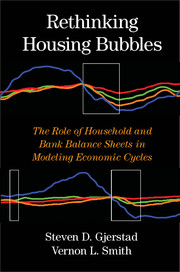 Rethinking Housing Bubbles
Rethinking Housing Bubbles Housing and the Great Recession
Published online by Cambridge University Press: 05 June 2014
[B]eing the managers rather of other people’s money than of their own, it cannot well be expected, that they should watch over it with the same anxious vigilance with which…(they) frequently watch over their own.
– Adam Smith (Wealth of Nations, Book V, Chap. 1, Part III)In the 1950s, I went to work for a mortgage brokerage firm in LA. When my father learned about my new job, he expressed concern. “You’re not going to bundle them, are you? That’s what brought on the Depression.”
– Personal correspondence from William A. Fraser, Jr., April 7, 2009Real estate bubbles occurred frequently during the past thirty years in both developing and advanced economies. Reinhart and Rogoff (2008) evaluated five major developed-country financial crises: Spain in 1977, Norway in 1987, Finland and Sweden in 1991, and Japan in 1992. They found that, averaged across the five crises, residential real estate prices peaked a year before the onset of the financial crisis; house prices had fallen by 22 percent four years after they had peaked. Rogoff and Reinhart (2009) extended their earlier analysis to twenty-two financial crises in both developed and developing countries and found that real estate prices fell in all of them, with a median decline of 35.5 percent. House prices declined more than 10 percent in twenty of the twenty-two crises. They also found that a typical financial crisis is associated with a substantial increase in unemployment and a decline in GDP that lasts for several years, followed by a large increase in government debt. Although their analyses indicated that house-price declines, unemployment, and equity market declines are all associated with financial crises, they did not indicate which factor or factors might have triggered the downturns and which are effects.
To save this book to your Kindle, first ensure no-reply@cambridge.org is added to your Approved Personal Document E-mail List under your Personal Document Settings on the Manage Your Content and Devices page of your Amazon account. Then enter the ‘name’ part of your Kindle email address below. Find out more about saving to your Kindle.
Note you can select to save to either the @free.kindle.com or @kindle.com variations. ‘@free.kindle.com’ emails are free but can only be saved to your device when it is connected to wi-fi. ‘@kindle.com’ emails can be delivered even when you are not connected to wi-fi, but note that service fees apply.
Find out more about the Kindle Personal Document Service.
To save content items to your account, please confirm that you agree to abide by our usage policies. If this is the first time you use this feature, you will be asked to authorise Cambridge Core to connect with your account. Find out more about saving content to Dropbox.
To save content items to your account, please confirm that you agree to abide by our usage policies. If this is the first time you use this feature, you will be asked to authorise Cambridge Core to connect with your account. Find out more about saving content to Google Drive.